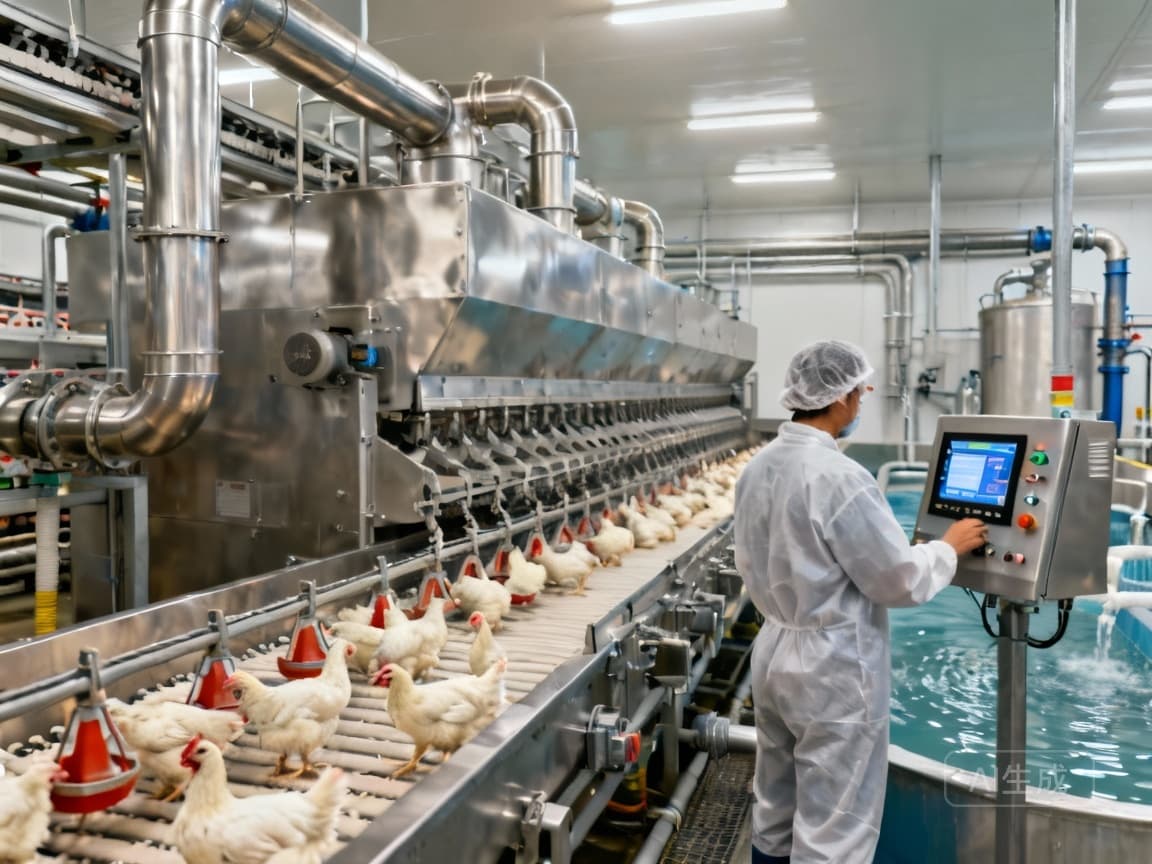Automation Cuts Water Use 48% & CO₂ by 33K Tons in Poultry Ops #43
Integrated automation cuts water use 48% and reduces CO₂ emissions by 33K tons in poultry operations, while driving market growth to $6.3B by 2035 with 6.0% CAGR.

The $6.3 Billion Opportunity: Why Integrated Automation is Reshaping Poultry Farming
The poultry farming equipment market is undergoing a fundamental transformation, with automation emerging as the cornerstone of modern, sustainable operations. According to Future Market Insights, the automatic segment is forecasted to contribute 48.0% of market revenue share in 2025, with the overall market anticipated to grow at a CAGR of 6.0% from 2025 to 2035, surpassing USD 6,300 Million by 2035. This growth is particularly concentrated in the chicken segment, which is expected to account for 65.0% of market revenue share in 2025.
What's driving this rapid adoption? Beyond traditional efficiency metrics, forward-thinking operations are recognizing that integrated automation systems deliver comprehensive environmental and economic benefits simultaneously. The market, valued at USD 4.5 billion in 2024, is projected to reach USD 7.1 billion by 2034, with the commercial segment dominating at 79% market share. This growth trajectory underscores the strategic importance of automation in meeting global poultry demand while addressing sustainability challenges.
Beyond Egg Production: Measuring Environmental ROI in Automated Poultry Systems
The environmental impact of automation extends far beyond operational efficiency. Real-world implementations demonstrate remarkable sustainability gains that directly translate to economic benefits. Taiwan Agricultural Research Institutions have pioneered advanced wastewater treatment systems and water recycling technologies that showcase the transformative potential of integrated automation.
Their implementation achieved a 66.7% reduction in water consumption, 33,000 tons CO2e reduction per year, and 48% reduction in water usage for specific applications while maintaining production standards.
These results aren't isolated. Multi-stage wastewater treatment systems provide substantial carbon reduction benefits, while advanced water recycling technologies dramatically reduce consumption without compromising production quality. The operational cost savings, though not specifically quantified in the study, are significant given the reduced resource consumption and waste management requirements.
Implementation Framework for Water Management
To achieve similar results, operations should implement a three-phase water management system:
- Phase 1: Automated Monitoring - Install smart water sensors that track consumption patterns and identify leaks in real-time
- Phase 2: Recycling Infrastructure - Implement closed-loop water systems with filtration and treatment capabilities
- Phase 3: Optimization Integration - Connect water management with feeding and climate control systems for holistic resource optimization
Timing Your Automation Investment: A Data-Backed Seasonal Implementation Guide
Strategic timing of automation investments can significantly impact implementation success and ROI. Search trend data reveals clear seasonal patterns that smart operations can leverage. According to market analysis, search volume for 'automatic chicken feeder' peaks at 100 in August 2025, while 'automatic chicken waterer' gains traction later in the year, rising from 0 to 41 by May 2025.
This data suggests a strategic implementation calendar:
- Q1 (January-March): Focus on feeder system upgrades and replacements, capitalizing on post-winter assessment periods
- Q2 (April-June): Implement climate control and ventilation automation ahead of summer heat stress periods
- Q3 (July-September): Launch waterer system promotions and installations to address peak summer demand
- Q4 (October-December): Plan comprehensive system integrations and prepare for winter automation needs
Technology Integration Roadmap
The latest poultry technology innovations, including AI and machine learning for understanding chicken vocalizations and computer vision for poultry monitoring, should be integrated in a phased approach. Drinking behavior changes that could predict poultry disease and AI-powered chick sexing to improve hatchery efficiency represent the next frontier of operational optimization.
The Integrated Poultry Sustainability Framework: Connecting Equipment, Environment and Economics
Successful automation implementation requires moving beyond piecemeal equipment upgrades to embrace a comprehensive sustainability framework. This integrated approach connects technological capabilities with environmental stewardship and economic performance.
The framework consists of four interconnected components:
- Smart Equipment Deployment: Automated feeding, watering, climate control, and monitoring systems
- Resource Management Systems: Water recycling, energy optimization, and waste treatment infrastructure
- Data Analytics Platform: Real-time performance monitoring, predictive maintenance, and optimization algorithms
- Sustainability Metrics: Carbon accounting, water usage tracking, and environmental impact assessment
Implementation Timeline and Milestones
For operations considering this framework, we recommend a 18-24 month implementation schedule:
- Months 1-3: Comprehensive operational assessment and baseline measurement
- Months 4-9: Core automation system deployment (feeding, watering, climate control)
- Months 10-15: Resource management infrastructure installation
- Months 16-24: Full system integration and optimization
The layer chicken breeding equipment market, valued at USD 0.31 billion in 2024 and expected to reach USD 0.41 billion by 2033, demonstrates the growing adoption of these integrated systems. Technological advancements in electric control, ventilation, and feeding systems are driving efficiency improvements across operations of all scales.
By embracing this comprehensive framework, poultry operations can achieve the dual objectives of environmental sustainability and economic performance. The demonstrated results from Taiwan's research institutions—48% water reduction and 33,000 tons of CO2e reduction annually—provide a compelling business case for integrated automation investment. As the market continues its strong growth trajectory, early adopters of these comprehensive systems will gain significant competitive advantage while contributing to a more sustainable agricultural future.
Want to know more?
Get in touch with us for more information about our services and products.